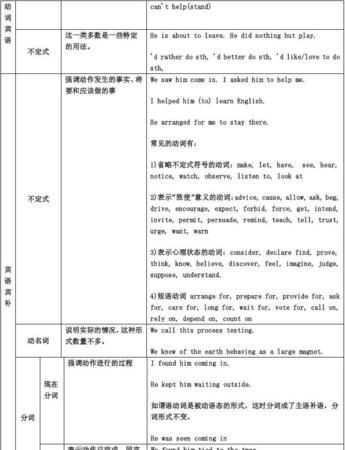本文目录
英语非谓语动词的用法总结
1 enjoy doing sth,由此第一个空格是playing;
2. 他妹妹享受做的事情(what),后面跟表语部分,即what is +动词不定式,即一个系表结构。
3. 答案:D

非谓语什么意思英语
是指英语里面的一种动词形态,它不是真正的谓语动词,但表达谓语动词的意思,所以用法上有将就。非谓语动词不定式(infinitive)I.基本形式:“to+动词原形”。有时to可省略。不能作谓语,没有人称和数的变化。既具有动词的特征----可以有自己的宾语和状语,又具有名词,形容词和副词的句法功能。不定式可以做主语,宾语,表语,定语,状语,同位语和宾语补足语式 态主动语态被动语态一般式to writeto be written完成式to have writtento have been written进行式to be writing完成进行式to have been writing不定式的否定式为:not+to doII.不定式的主动语态与被动语态:a. 一般式:表示谓语动词的动作与不定式的动作几乎同时发生,或发生在谓语动作之后。We must learn to speak EnglishI want to be a scientist when I grow up.b. 完成式: 表示不定式的动作早于谓语动词的动作发生。I'm sorry to have given you so much trouble.It's a good thing for him to have beencriticized.c.进行式:表示谓语动词的动作发生的时候,不定式的动作正在进行。He seems to be waiting for somebody.He pretended to be listening attentively.注:在某些结构中(尤其做宾语时, 不定式虽然表被动,但是用主动形式表示。 1.在的there be句式中,不定式的主动式可表被动的意思。There is no matter to drink here.2)当不定式与前面的名词构成动宾关系,又与另一代词或名词构成主谓关系,这时不定式的主动可以表被动。We have many difficulties to overcome.The next thing for them to do is to sweep the floor.He has no one to take care of. 1.当不定式做表语形容词的状语,又和句中的主语构成动宾关系,这时不定式的主动形式表被动意味。常可这样用的形容词一般1有以下几个:easy ,difficult , afraid, hard ,heavy,pleasant, nice, dangerous, important, interesting, bitter, light 等。They found the report was hard to understand.4) to let(出租),blame用主动代替被动形式表被动意味。The car is to let.III.句法功能: 1.做主语:当主语是个动宾结构时,或动状结构时,这时用不定式做主语。To learn English well is not easy.不定式短语做主语时,为了保持句子的平衡,往往以先行词做形式主语,而把不定式短语置于谓语动词之后。It's so nice to hear your voice.It cost us 5 0000 yuan to build the house. 1.作表语:a. 当表语是动宾结构或动状结构时,用不定式做表语。My job is to raise pigs. a.当主语是不定式时,表语也要用不定式。To see is to believe. a.主语是由动词转化或派生而来的名词,如果原动词要求接不定式,则表语也应当用不定式。 to buy a new car.My wish/hope/ idea/plan/purpose/intention is to visit Africa.to be a college student 1.作宾语:某些动词后,只能用不定式作宾语。如: allow ,afford, agree, apply, arrange, ask, choose, claim, decide, demand, desire, determine, expect, hope, wish, learn, manage, offer, pretend, promise, refuse, threaten等。We decided not to go with the work.Einstein once refused to speak on the radio for $ 1,000 a minute.有些动词既可接不定式作宾语,也可接动名词作宾语, 如:want, begin ,start, remember, need, forget, like, learn等,含义稍有不同。区别将在非谓语用法区别中讲解。注:a. 如果作宾语的不定式有自己的补语,则一般用先行词it做形式宾语,而将真正的宾语不定式后置。Do you think it better to translate in this way?They found it impossible to get there everything ready in time.2b. 不定式一般不做介词宾语,只有在极少数介词如:but, except ,besieds等后才行。此时不定式可带to或不带to。But前无动词do时,其后接带to的不定式:but前有动词do时,其后的不定式to常省略。In very cold winter weather a cold-blooded creature has no choice but to lie down and sleep.There was clearly nothing left to do but sit down on the little coach and weep.What do you like to do besides swim.但 “疑问词+不定式” 结构可以用做介词宾语.I have no idea about what to donext.The first was the question of what to call it 1.宾语补足语: 常带有不定式做宾语补足语的动词有(1). ask, force, expect, encourage,teach, cause, allow, beg, forbid, invite, permit, persuade, remind, want, warn, tell等.He told me to make a sentence with the word.(2). see, watch, notice, observe ; let, make, have ; listen to hear ;feel 这些动词后的不定式宾补,要省略 “to”. 但要变为被动语态时,要加上toShe had the pupils work out the problem.5). 定语: 放在它所修饰的名词或代词之后.不定式与它所修饰的名词或名词词组之间的关系为 A: 名词或名词词组是不定式的逻辑宾语; B: 名词或名词词组为不定式的逻辑主语. C:名词或名词词组与不定式既无动宾关系又无主谓关系A: He gave me something to eat.B: He needs someone to help him with his work..C: I have no time to do it.He has no money to buy the car.We must find a place to live.I have a better way to repair it.注: 带疑问词的不定式不直接做定语:(x ) That's the only way how to solve the problem.That's the only way to solve the problem.不定式做定语时可带逻辑主语,而且常用for引出.I have a letter for you to read.不定式一般作定语时,往往含有将来,必须等附加意味,相当一个定语从句.3 1.状语:目的状语:Yesterday I went to the station to meet my old brother.Mr. Smith came to China to studyChinese.常用的强调目的的短语in order to; so as to结果状语:He returned home tohear that his con has just join the army.He hurried to the school to find nobody there.常用的短语:so (such… as to +v.); too….to ; enough to +v.原因状语:(常表示喜怒哀乐等情绪)We were very excited to hear thenews.I'm glad to see you.表语形容词状语:结构为 be+adj. +to do sth.The article is easy to read.The man is hard to work with.We likely to attend the class.7)“疑问词+不定式”结构:主语: How to get rid of these things is a big question.宾语:I hardly knew how to write.表语:The question is where to find the answer. 1.定式的省略:A: 当两个或两个以上的不定式并列在一起时,第一个不定式带to,后面的不定式往往把to省去。Eg:I wished to finish my task and (to) get away.但是如果在对照的场合,则不可以省去:It is better to laugh thanto cry.B: 在感官动词see, hear, feel, watch, notice observe, listen to , look at 和使役动词let, make have的复合宾语中,不定式须省去to被动语态中要加上to.C: 在why引起的句子中省去to: Why not do it right now?Why quarrel with him?D: 在一些固定搭配后面,如:had better; would/had rather; but等,不用toE: help sb. (to) do sth.此句式中,可用to也可不用to.-ing form-ing form 既具有动词的一些特征(可带自己的宾语又可有自己的状语)又具有形容词,副词(现在分词)和名词(动名词)的句法功能。其形式为:v+-ing。现在分词表示动作正在进行和主动意味。一般式:dongI.(现在分词和动名词)主动语态:完成式:having done一般式:being done被动语态:完成式:having been done4主动语态一般式:表示动作与谓语动词的动作同时发生,或在谓语动词动作之前发生eg: I saw her running towards me.Hearing the bad news, she burst into tears.主动语态完成式:表示动作发生在谓语动词之前,常做时间或原因状语。Eg: Heaving finished my homework, I went to bed.Having been shot by a bullet ,theboy fell down.被动语态一般式:所表示的动作发生与谓语动词动作同时发生。Eg: The building being repaired isour library.被动语态完成式:所表示的动作发生在谓语动词的动作之前。Eg: Not having been made preparations, they thought it better to put off the meeting until the next week.否定式为:not +-ing (not having done)II.句法功能:1 现在分词:1) 用做谓语的一部分,和助动词一起够成进行时态What are you doing here now?2) 作表语:表示主语的特征和性质。They situation is encouraging.The story is interesting.3) 作定语:相当于一个定语从句。分词单独作定语,通常放在被修饰的名词前。若是分词短语作定语,放在被修饰的名词后。表示:a. 所修饰名词正在进行的动作;b. 所修饰名词的特征和性质。Don't read in a moving car or bus.There was an old man standing besideme.This is an interesting book.4)作状语:相当于一个状语从句。a. 时间状语:Working in factory, welearnt a lot from the workers.有时前面可加 while, when, as.He took notes while listening to report.b. 原因状语: Having worked with him for many years, I know him very well.Not having received his answer Idecided to write another letter to him.c. 条件状语:(If) Playing all day, youwill waste your valuable time.(这类状语5分词前有时可加连词if,unless)d. 方式状语(伴随状语):Holding the note in his hand, he stood there dumfound.(常用的动词有:sit, stand, go, come, enter, walk, say.)e.结果状语:He dropped the plate, breaking it into a hundred pieces.f. 宾语补足语:分词在复合宾语中可做宾补。可带这种复合宾语的动词有see, set, want, start , watch, feel, hear, find, get, keep, notice, have, leave, catch,look at,eg.: We hear her sing in her room.We can see steam rising from thewet clothes.This news started me thinking.分词的名词化: 和形容词的名词化情况一样,一些分词前面加上定冠词the可表一类人。She worked hard to help the sick and the dying.The wounded were soon taken to hospital. 1.动名词(gerund):句法功能:1).主语: 当主语是动宾,动状结构时,用动名词来做主语。Discussing it is waste of time.Reading aloud is very important in learning English.当作主语的动名词结构复杂而又长时,为了保持句子的平衡,须后置,而用先行词作句子的主语。It is no use crying over spilt milk.It is no good reading such books.It is a waste of time reading such bad books.It is fun playing with snow.It is worth while discussing the question again.在 there+be+no 句式中用动名词来做主语。There is no telling what will happen.2)表语:当主语是动宾或动状结构时,用动名词来作表语。Her job is washing, leaning and takingcare of the children.What he hated most was resting at home and doing nothing.注:(1) 句子的主语常是无生命名词或引导的名词性从句。(2) 表语动名词与主语是对等关系,表示主语的内容。回答what或dong what的问题。3) 宾语:动名词可作动词宾语,介词宾语和形容词具有状语性质的宾语。 1.动宾:有些动词后必须用动名词作宾语。如:6suggest, finish, can't help, mind, enjoy,advise, miss, practice, put off, excuse, pardon, be proud of, avoid, risk, appreciate, escape 等。e.g.: He suggested spending the evening with the workers.I enjoy working with you.(2) 介词宾语:I have been looking forward to coming Beijing for a long time.He is afraid of falling behind the others.(3) 作形容词 worth, busy, like的具有状语性质的宾语。be worth doing sth.: This book isworth reading.be busy doing sth.: He is busy preparing his lesson.feel like doing sth.: I don't feel like going there again.注:如果作宾语的动名词有自己的补语,习惯上要将动名词后置,而用先行词it作它的宾语。 E.g.: I found it pleasant walking along the river.4)定语:放在所修饰的名词前,与所修饰的名词没有主谓关系,而是表示所修饰名词的用途。 a sleeping car a fishing pole5) 同位语:That was her desire,going on to college after finishing senior middle school.动名词的复合结构动名词的复合结构的形式为:物主代词(或名词所有格)+动名词。其中物主代词或名词所有格为动名词的逻辑主语。动名词的复合结构在句中做主语,宾语和表语。E.g.: Mary's coming late made herteacher very angry.Do you mind my opening the window.在口语中,如果这种结构作宾语时,其中的物主代词常用人称代词的宾格来代替,用名词的普通格来代替名词所有格。如:Do you mind (me) opening the window?注:不过动名词的逻辑主语在遇有下列情况时,必须用名词的普通格(或人称代词的宾格)。 1.无生命词:The boy were alarmed by the door suddenly shutting.Fire burns better by oxygen being at work.(2) 有生命名词但表示 泛指意义。Have you ever heard of women playing football?(3) 两个以上的有生命名词并列:Do you remember my brother and me coming to see you the other day?7过去分词(past participle)I.形式:v.+ed (或特殊形式)表示动作已完成(不及物动词),被动意味和状态。the exploited class 被剥削阶级 boiled water 开水II.句法功能: 1.用做谓语的一部分,和助动词一起构成完成时态及被动语态。We have been friends for many years.His leg was hurt in an accident.2. 表语:表示主语所处的状态Don't be excited!The door remained locked.3. 定语:单个过去分词作定语,通常放在所修饰的名词前,若是短语作定语放在所修饰的名词之后。We enjoyed the play put on by the first years students.(=We enjoyed the play which was put on by the firstyear students.the fallen leaves the excited people4. 状语:时间状语When heated, ice will be changed into water.(=When it is heated,…)条件状语Given better instructions, the plants could have grown better.(=If they had been given…,)原因状语Given an apple, the child stoppedcrying.5. 宾补:She had his bike repaired yesterday.在英语中,有些动词即可接不定式作宾语,也可接-ing form(动名词)作宾语。有些意义区别不大,有些区别较大。如: 1.remember:remember +to do 记住要作某事remember + doing 记得过去曾经作过某事Please remember to post the letter forme.I remember posting the letter. 1.forget +to do 忘记要作的事forget + doing 忘记了过去作过的事He forgot to write to me.He forgot ever having written to me. 1.regret + to do 对现在要发生的事或要做而又不能做的事感到遗憾8regret + doing 对已发生的事表示后悔I regret to say (that) I cannot go withyou.She regretted missing (or having missed =to have missed )the report. 1.mean +to do 打算…; 想要……;有…的意图mean + doing 意味着…; 意思是…; 就是…I didn't mean to hurt your feelings.Revolution means liberating the productive forces. 1.stop + to do 停下正在做的事而去做由不定式表示的另一件事stop + doing 停止正在做的事They stopped to talk.They stopped talking. 1.try + to do 设法…; 想法….;try + doing 试一试…; 试试看He tried hard to pretend to share in the pleasure of his officials.If the tears don't remove the speak, try washing the eyes with boiled, cooled water. 1.want + to do 想要…want + sb. or sth. + to do 想要某人做…; 希望某人…want + doing 需要…; 该…(动名词的主动式含有被动意味)Somebody wants to see you.I want you to show me with your hearts that here we are all part of onebig family.The matter wants thinking over. 1.need + to do 需要…need + doing 需要…;该…You don't need to leave so early.His shoes need mending. 1.require + sb. or sth. + to do 要求(需要) 某人(某事) 做require + doing 需要…; 该…One of his orders required all the people to bow before him.These young trees will require lookingafter. 1.learn + to do 学会做某事learn + doing 学习(过)She has learned typing.She has learned the type.等等等等。。。

以上就是关于非谓语的英语翻译,英语非谓语动词的用法总结的全部内容,以及非谓语的英语翻译 的相关内容,希望能够帮到您。

